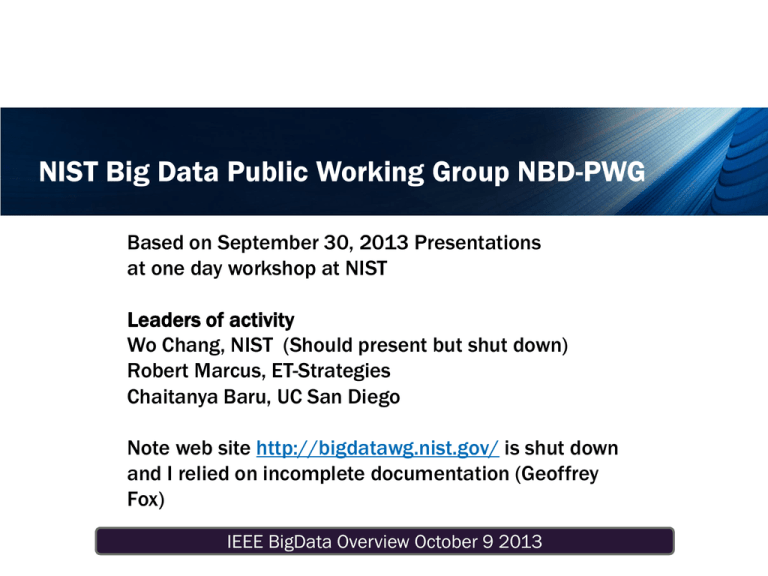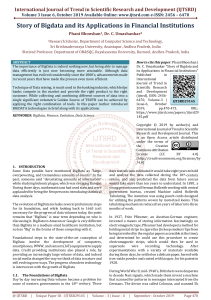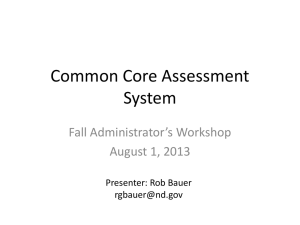NIST Big Data Working Group
advertisement

NIST Big Data Public Working Group NBD-PWG Based on September 30, 2013 Presentations at one day workshop at NIST Leaders of activity Wo Chang, NIST (Should present but shut down) Robert Marcus, ET-Strategies Chaitanya Baru, UC San Diego Note web site http://bigdatawg.nist.gov/ is shut down and I relied on incomplete documentation (Geoffrey Fox) IEEE BigData Overview October 9 2013 NBD-PWG Charter Launch Date: June 26, 2013; Public Meeting with interim deliverables: September, 30, 2013; Edit and send out for comment Nov-Dec 2013 • The focus of the (NBD-PWG) is to form a community of interest from industry, academia, and government, with the goal of developing a consensus definitions, taxonomies, secure reference architectures, and technology roadmap. The aim is to create vendor-neutral, technology and infrastructure agnostic deliverables to enable big data stakeholders to pick-and-choose best analytics tools for their processing and visualization requirements on the most suitable computing platforms and clusters while allowing value-added from big data service providers and flow of data between the stakeholders in a cohesive and secure manner. • Note identify common/best practice; includes but not limited to discussing standards (S in NIST) 9/29/13 IEEE BigData Overview October 9 2013 2 NBD-PWG Subgroups & Co-Chairs • Requirements and Use Cases SG – Geoffrey Fox, Indiana U.; Joe Paiva, VA; Tsegereda Beyene, Cisco • Definitions and Taxonomies SG – Nancy Grady, SAIC; Natasha Balac, SDSC; Eugene Luster, R2AD • Reference Architecture SG – Orit Levin, Microsoft; James Ketner, AT&T; Don Krapohl, Augmented Intelligence • Security and Privacy SG – Arnab Roy, CSA/Fujitsu Nancy Landreville, U. MD Akhil Manchanda, GE • Technology Roadmap SG – Carl Buffington, Vistronix; Dan McClary, Oracle; David Boyd, Data Tactic 9/29/13 IEEE BigData Overview October 9 2013 3 Requirements and Use Case Subgroup The focus is to form a community of interest from industry, academia, and government, with the goal of developing a consensus list of Big Data requirements across all stakeholders. This includes gathering and understanding various use cases from diversified application domains. Tasks • Gather use case input from all stakeholders • Derive Big Data requirements from each use case. • Analyze/prioritize a list of challenging general requirements that may delay or prevent adoption of Big Data deployment • Work with Reference Architecture to validate requirements and reference architecture • Develop a set of general patterns capturing the “essence” of use cases (to do) 9/29/13 IEEE BigData Overview October 9 2013 4 Use Case Template • 26 fields completed for 51 areas • Government Operation: 4 • Commercial: 8 • Defense: 3 • Healthcare and Life Sciences: 10 • Deep Learning and Social Media: 6 • The Ecosystem for Research: 4 • Astronomy and Physics: 5 • Earth, Environmental and Polar Science: 10 • Energy: 1 9/29/13 IEEE BigData Overview October 9 2013 51 Detailed Use Cases: Many TB’s to Many PB’s • Government Operation: National Archives and Records Administration, Census Bureau • Commercial: Finance in Cloud, Cloud Backup, Mendeley (Citations), Netflix, Web Search, Digital Materials, Cargo shipping (as in UPS) • Defense: Sensors, Image surveillance, Situation Assessment • Healthcare and Life Sciences: Medical records, Graph and Probabilistic analysis, Pathology, Bioimaging, Genomics, Epidemiology, People Activity models, Biodiversity • Deep Learning and Social Media: Driving Car, Geolocate images, Twitter, Crowd Sourcing, Network Science, NIST benchmark datasets • The Ecosystem for Research: Metadata, Collaboration, Language Translation, Light source experiments • Astronomy and Physics: Sky Surveys compared to simulation, Large Hadron Collider at CERN, Belle Accelerator II in Japan • Earth, Environmental and Polar Science: Radar Scattering in Atmosphere, Earthquake, Ocean, Earth Observation, Ice sheet Radar scattering, Earth radar mapping, Climate simulation datasets, Atmospheric turbulence identification, Subsurface Biogeochemistry (microbes to watersheds), AmeriFlux and FLUXNET gas sensors • Energy: Smart grid • Next step involves matching extracted requirements and reference architecture • Alternatively develop a set of general patterns capturing the “essence” of use cases 9/29/13 IEEE BigData Overview October 9 2013 Definitions and Taxonomies Subgroup • The focus is to gain a better understanding of the principles of Big Data. It is important to develop a consensus-based common language and vocabulary terms used in Big Data across stakeholders from industry, academia, and government. In addition, it is also critical to identify essential actors with roles and responsibility, and subdivide them into components and sub-components on how they interact/ relate with each other according to their similarities and differences. Tasks • For Definitions: Compile terms used from all stakeholders regarding the meaning of Big Data from various standard bodies, domain applications, and diversified operational environments. • For Taxonomies: Identify key actors with their roles and responsibilities from all stakeholders, categorize them into components and subcomponents based on their similarities and differences 9/29/13 IEEE BigData Overview October 9 2013 7 Data Science Definition (Big Data less consensus) Big Data refers to digital data volume, • Data Science is the extraction of actionable knowledge directly from velocity and/or variety whose management requires scalability across data through a process of discovery, coupled horizontal resources hypothesis, and analytical hypothesis analysis. • A Data Scientist is a practitioner who has sufficient knowledge of the overlapping regimes of expertise in business needs, domain knowledge, analytical skills and programming expertise to manage the end-to-end scientific method process through each stage in the big data lifecycle. 9/29/13 IEEE BigData Overview October 9 2013 8 Reference Architecture Subgroup The focus is to form a community of interest from industry, academia, and government, with the goal of developing a consensus-based approach to orchestrate vendor-neutral, technology and infrastructure agnostic for analytics tools and computing environments. The goal is to enable Big Data stakeholders to pick-andchoose technology-agnostic analytics tools for processing and visualization in any computing platform and cluster while allowing value-added from Big Data service providers and the flow of the data between the stakeholders in a cohesive and secure manner. Tasks • Gather and study available Big Data architectures representing various stakeholders, different data types,’ use cases, and document the architectures using the Big Data taxonomies model based upon the identified actors with their roles and responsibilities. • Ensure that the developed Big Data reference architecture and the Security and Privacy Reference Architecture correspond and complement each other. 9/29/13 IEEE BigData Overview October 9 2013 9 List Of Surveyed Architectures • Vendor-neutral and technology-agnostic proposals – – – – Bob Marcus Orit Levin Gary Mazzaferro Yuri Demchenko ET-Strategies Microsoft AlloyCloud University of Amsterdam • Vendors’ Architectures – – – – – – – 9/29/13 IBM Oracle Booz Allen Hamilton EMC SAP 9sight LexusNexis IEEE BigData Overview October 9 2013 10 I N F O R M AT I O N V A L U E C H A I N Visualization Analytics Access DATA SW SW SW Big Data Framework Provider Processing Frameworks (analytic tools, etc.) Horizontally Scalable Vertically Scalable Platforms (databases, etc.) Horizontally Scalable Vertically Scalable Infrastructures Horizontally Scalable (VM clusters) Vertically Scalable Physical and Virtual Resources (networking, computing, etc.) 9/29/13 IEEE BigData Overview October 9 2013 11 I T VALUE CHAIN Curation Management Collection Security & Privacy DATA DATA Data Provider Big Data Application Provider Data Consumer System Orchestrator Security and Privacy Subgroup The focus is to form a community of interest from industry, academia, and government, with the goal of developing a consensus secure reference architecture to handle security and privacy issues across all stakeholders. This includes gaining an understanding of what standards are available or under development, as well as identifies which key organizations are working on these standards. Tasks • Gather input from all stakeholders regarding security and privacy concerns in Big Data processing, storage, and services. • Analyze/prioritize a list of challenging security and privacy requirements from ~10 special use cases that may delay or prevent adoption of Big Data deployment • Develop a Security and Privacy Reference Architecture that supplements the general Big Data Reference Architecture 9/29/13 IEEE BigData Overview October 9 2013 12 CSA (Cloud Security Alliance) BDWG: Top Ten Big Data Security and Privacy Challenges 1) 2) 3) 4) 5) 6) 7) 8) 9) 10) Secure computations in distributed programming frameworks Security best practices for nonrelational datastores Secure data storage and transactions logs End-point input validation/filtering Real time security monitoring Scalable and composable privacypreserving data mining and analytics Cryptographically enforced access control and secure communication Granular access control Granular audits Data provenance 4, 8, 9 1, 3, 5, 6, 7, 8, 9, 10 10 4, 10 2, 3, 5, 8, 9 Data Storage Public/Private/Hybrid Cloud 5, 7, 8, 9 9/29/13 IEEE BigData Overview October 9 2013 13 Top 10 S&P Challenges: Classification Infrastructure security 9/29/13 Data Privacy Data Management Integrity and Reactive Security Secure Computations in Distributed Programming Frameworks Privacy Preserving Data Mining and Analytics Secure Data Storage and Transaction Logs End-point validation and filtering Security Best Practices for NonRelational Data Stores Cryptographically Enforced Data Centric Security Granular Audits Real time Security Monitoring Granular Access Control Data Provenance IEEE BigData Overview October 9 2013 14 Use Cases • Retail/Marketing – Modern Day Consumerism – Nielsen Homescan – Web Traffic Analysis • Healthcare – Health Information Exchange – Genetic Privacy – Pharma Clinical Trial Data Sharing • Cyber-security • Government – Military – Education 9/29/13 IEEE BigData Overview October 9 2013 15 Technology Roadmap Subgroup The focus is to form a community of interest from industry, academia, and government, with the goal of developing a consensus vision with recommendations on how Big Data should move forward by performing a good gap analysis through the materials gathered from all other NBD subgroups. This includes setting standardization and adoption priorities through an understanding of what standards are available or under development as part of the recommendations. Tasks • Gather input from NBD subgroups and study the taxonomies for the actors’ roles and responsibility, use cases and requirements, and secure reference architecture. • Gain understanding of what standards are available or under development for Big Data • Perform a thorough gap analysis and document the findings • Identify what possible barriers may delay or prevent adoption of Big Data • Document vision and recommendations 16 9/29/13 IEEE BigData Overview October 9 2013 Some Identified Features 9/29/13 09.30.2013 Feature Roles Readiness Ref Architecture Mapping Storage Framework TBD TBD Capabilities Processing Framework TBD TBD Capabilities Resource Managers Framework TBD TBD Capabilities Infrastructure Framework TBD TBD Capabilities Information Framework TBD TBD Data Services Standards Integration Framework TBD TBD Data Services Applications Framework TBD TBD Capabilities Business Operations TBD TBD Vertical Orchestrator Technology Roadmap IEEE BigData Overview October 9 2013 17 Interaction Between Subgroups Requirements & Use Cases Reference Architecture Security & Privacy Technology Roadmap Definitions & Taxonomies Due to time constraints, activities were carried out in parallel. 9/29/13 IEEE BigData Overview October 9 2013 18







